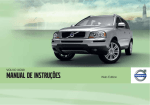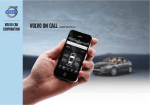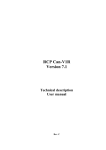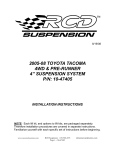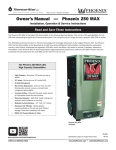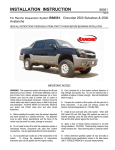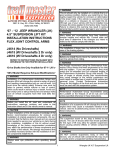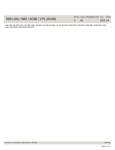Download 891: Cable harness kit for towbar, 7/4-pin Cable
Transcript
891: Cable harness kit for towbar, 7/4-pin XC90, 2007, B8444S, TF-80SC AWD, L.H.D, YV4CZ852671372388, 372388 20/6/2014 PRINT 891: Cable harness kit for towbar, 7/4-pin Cable harness kit for towbar, 7/4-pin Installation instruction: 30756532 INTRODUCTION Read through all of the instructions before starting installation. Notifications and warning texts are for your safety and to minimise the risk of something breaking during installation. Ensure that all tools stated in the instructions are available before starting installation. Certain steps in the instructions are only presented in the form of images. Explanatory text is also given for more complicated steps. In the event of any problems with the instructions or the accessory, contact your local Volvo dealer. Cars equipped with SRS/SIPS (Airbag) Warning! Extra care must be taken when working on cars equipped with SRS/SIPS air bags. This is important to prevent: 1. Personal injury 2. Damage to or malfunction of the SRS/SIPS system. Work on the SRS/SIPS systems or related components must always be carried out by an authorised Volvo workshop. Is the car equipped with SRS (supplemental restraint system)? Cars equipped with a driver's airbag have the letters "SRS" imprinted on the centre panel of the steering wheel. Cars equipped with driver's and passenger airbags are marked with "SRS" on both the steering wheel centre panel and also on the dashboard close to the airbag. If the car is equipped with SIPS (side impact protection system ) a "SIPS" decal is marked on both the front seats. Cars equipped with inflatable curtains have the marking "SRS" on one of the panels along the posts on the inside of the car. Cars equipped with SRS (supplemental restraint system) also have an "SRS" decal on the front windscreen. Warning! The air bag inflation areas must not be obstructed. Never place any objects, such as upholstery or accessories, within these areas. The panels must be able to open in the correct manner at the right time, otherwise there is an increased risk of personal injury in the event of a collision. Do not damage the SRS wiring! Do not trap, chafe, pierce or damage the SRS wiring. SRS wiring has orange casing and/or is plaited. Steering and front suspension The contact reel in the SRS system can easily be damaged when working on the steering wheel, steering shaft or steering gear. Refer to the SRS (supplemental restraint system) Service Manual or service instructions in VIDA for information on carrying out such work. This is to prevent damage. SRS warning lamp If the SRS warning lamp lights after repairs have been carried out, take the car to an authorised Volvo workshop. Supplemental restraint system module, SRS C30/S40(04-)/V50/S60/XC60/C70(06)/V70/XC70/S80/XC90 The supplemental restraint system module (SRS) is located on the tunnel under the centre console, in front of the parking brake. Warning! The ignition must be in position "0" and the key removed from the ignition switch if any connector in the SRS system is to be unplugged. Then wait at least three minutes and disconnect the battery negative lead before unplugging any of the connectors. When work is completed, the ignition key must be turned to position "II" before reconnecting the battery negative lead. Cable harness kit for towbar, 7/4-pin Illustration A Install the trailer connector with the four screws and the nuts. Tighten. Pull the cable harness out towards the right along the front edge of the tow bar member. Secure the cable harness with a tie strap on the sides of the tow bar member brackets. Figure B applies to cars with R-design Skidplate On cars with Skidplate, the contact shall be turned 90° counter-clockwise in relation to the placement in Figure A. Applies to cars with two rows of seats Fold up the centre rear floor hatch (1). If the underside of the floor hatch is equipped with a grocery bag holder, the holder is secured with a strap on both ends of the storage compartment. Detach the straps. Remove the underlying storage compartment. Remove the floor hatch by folding it almost completely closed and pulling it backwards from the mountings until it releases. Applies to cars with three rows of seats and integrated carrier bag holder on the underside of the centre floor hatch Fold up the centre rear floor hatch (1). Detach the two straps on the underlying panel. Lift up the rear edge of the panel, fold the floor hatch back towards the panel and lift out the floor hatch with the panel. Applies to cars with three rows of seats without an integrated carrier bag holder Fold up the centre rear floor hatch (1) at the rear edge and lift it out. Applies to all models Remove the left-hand side floor hatch (2). Remove the folding side panel from the left-hand side in the cargo compartment. Remove the three screws in the battery holder. Lift the battery holder out. Remove the battery cover. Pull off the rubber strip at the rear edge of the door opening for the left-hand rear door opposite the left-hand C-post panel. Carefully pry off the left-hand C-post panel sides at the top. Use a plastic weatherstrip tool. Then pull until the three clips on the inside release. Do not damage the headlining or the panel. Remove the panel by pulling upwards slightly and unhooking it from the side panel. Remove the rear roof panel covers and the screws beneath them. Carefully pry off the panel at the rear edge. Use a plastic weatherstrip tool. Pull the rear edge of the panel downwards until the four clips on the top release. If the car is equipped with lighting in the panel, unplug the connector from the panel. Pull the panel backwards to release it. Carefully pull off the D-post panel. Start at the top edge then pull down until the three clips on the inside release. Do not damage the panel. Disconnect the connector on the D-post panel (if the car has a loudspeaker in the D-post, the connector is in the loudspeaker). Remove the panel by pulling upwards slightly and unhooking it from the side panel. Illustration A shows the removal of the cover for the load securing eyelets Fold out the load securing eyelet. Insert a scriber with an angled tip into the hole in the top of the cover. Turn the scriber so that the angled tip engages in the reverse of the cover (1). Pull the cover off. Illustration B applies to cars with two rows of seats Illustration C applies to cars with three rows of seats Fold up the seats in the third row (applies to cars with three rows of seats). Remove the screws (2) for the load securing eyelets in the left-hand side panel. Remove the covers (3) over the front mountings for the left-hand side panel. Pry the covers off. Use a plastic weatherstrip tool or a small screwdriver. Remove the screws (4). Remove the clip (5) at the bottom of the storage compartment in the panel (Applies to cars with three rows of seats). Remove the panel by pulling out the upper edge slightly so that the clips on the inside release. Pull the panel straight up. Remove the drain hose (1) from the battery. Remove the rubber seal (2). It will not be re-used. Pull off the small, thin rubber strap on the new rubber seal. Insert the old drain hose through the new rubber seal. Make sure the hose is not obstructed and that it is not folded. Illustration A Route the cable harness from the tow bar connector through the hole in the floor. Adjust the position of the rubber seal (1) so that there is not excessive cable slack under the car. Install the rubber seal in the hole. Route the cable harness as illustrated. Insert it through the hole along the rear edge of the lefthand cargo floor support. Secure the cable harness to the cable harness behind the battery with tie straps (2) from the kit. Illustration B Connect the routed ground cable to the grounding point (3) behind the battery and tighten the grounding screw securely. Connect the drain hose (4) to the battery. Make sure the cable harness curves around the lower edge of the bumper as shown in the illustration. Note! If the cable harness is stretched too tightly, it can scrape against the lower edge of the bumper and become damaged. Note! On the XC90 Executive, T-wiring is already installed in the fuse holder. As this is a cable with a black connector taped to it. The tow bar wiring's black connector is then connected to this. Detach the trailer module (TRM) from the Velcro fastener on the floor along the rear edge of the left-hand rear wheel housing. Plug in the tow bar wiring connectors: green (GN) and grey (GR) connectors to the control module. black (SB) connector to the fuse holder. Reinstall the control module. Secure the excess cable with a tie strap from the kit. Insert fuses from the kit in the following positions in the fuse holder (REM): 20A in position 20 (mini fuse) if the charging function will be used 25A in position 29 25A in position 30. Reinstall: the left-hand side panel using the screws and cover. Tighten the screws in the load securing eyelets. Tighten to 24 Nm (18 lbf ft) . the covers for the load securing eyelets. D-post panel with connector. the connector for the rear roof lighting (if applicable). the rear headlining. C-post panel. protective cover and bracket for the battery. side floor hatch and folding panel. storage compartment and floor hatch. Checking the trailer connector 1. 2. 3. 4. 5. 6. 7. 7-pin connection Brake lamp / Left-hand indicator lamp Ground Spare (Brake lamp, Electric brakes) Brake lamp / Right-hand indicator lamp Charging Position lamps Spare (Reversing lamp) The cable to pin 3 is blue (BL) and the cable to pin 7 is violet (VO). They are taped to the wiring approximately 1 meter from the connector. 1. 2. 3. 4. 4-pin connection Brake lamp / Right-hand indicator lamp Brake lamp / Left-hand indicator lamp Position lamps Ground Note! The following steps (16-25) only apply if further functions are desired. These parts are not included in the kit. Specified part numbers can be purchased separately from Volvo dealerships. Steps 16-23 only apply if electric brakes are to be installed. The image with wiring diagram shows the principle of electric brake connection. The system must be fused with quick-acting fuse, maximum 30A, and controlled with relay, see diagrammatic illustration. Use Maxi fuse (P/N 9441158), quick-acting fuse max. 30A by ATO (P/N 966331) or Mini (P/N 8470580) type. A separate holder must be used for these. Note! Installation of equipment for the electric brakes must be carried out according to the supplier's instructions. Volvo takes no responsibility for such equipment. Obtain positive feed (30+) from position 3 in the main fuse box, which is located beside the battery. Insert a 40A Midi fuse in the holder (P/N 9441937). Connection of relay control to "Ignition on" in the rear electronic module (REM) Press in the catch on the front black connector in the cargo compartment fuse holder. Turn up the lock arm as far as possible and pull out the connector. Carefully prise apart the sides of the connector holder in the ends so that the connector can pass by the retaining hooks. Pull the connector out from the holder. Connect a replacement part terminal (P/N 30656727) to position 30 in the connector. Reinstall the connector in the holder and reinstall the whole unit in the fuse holder. Connect ground lead (31-) to the relay with a conductor with cable terminal (P/N 970784) to the existing ground terminal (1) behind the battery. Tighten the ground screw firmly. Only applies if the brake lamp signal is to be connected to the electric brakes Connect a replacement part terminal (P/N 30656647) to position 1 in the tow hitch wiring's gray connector on the trailer module (TRM). Splice it with the cable for the brake lamp's input signal from the brake equipment, with a yellow butt connector (P/N 9130477). Connect the electric brakes after the relay with a fuse, maximum 30A. Connect the electric brake output to the trailer connector via pin 3, spare (see step 15). The cables should have a minimum 4 mm² crosssection if a 30A fuse is used. The equipment will be supplied with power as long as the car has its ignition on. Note! If the electric brakes are connected without relay control in accordance with above, then there is a risk that the car's battery will be discharged. Only applies if the brake lamp function is to be used. Connect a replacement part terminal (P/N 30656647) to position 1 in the tow hitch wiring's gray connector on the trailer module (TRM). Splice it with the blue (BL) cable that is taped to the wiring, with a yellow butt connector (P/N 9130477). The brake lamp signal is now in position 3 in the trailer connector. Only applies if the reverse lamp function is to be used. 20/6/2014 Connect a replacement part terminal (P/N 30656724) to position H in the tow hitch wiring's black connector on the fuse holder (REM). Splice it with the violet (VO) cable that is taped to the wiring, with a yellow butt connector (P/N 9130477). The reverse lamp signal is now in position 7 in the trailer connector. PRINT

















